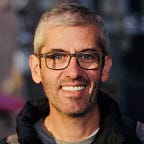My journey through Franco Farinelli’s “L’invenzione della Terra”
As a teenager, I spent most of my summers alone, walking and swimming on the beach. Observing the horizon, thinking about what is on the other side of this line, how they live there. If someday I would be allowed to visit this place.
I only could imagine all this because my professors explained that the Earth is not a flat piece of land. After all, an old gentleman once showed me an Atlas, a magic book of maps that allowed me to travel in my imagination all over this planet.
Franco Farinelli in his “L’invenzione della Terra” allowed me again to travel over the thinking behind all these conceptualizations of our land, sea, and air. Philosophers, mathematicians, and thinkers who, since the early civilizations dedicated their lives to understanding and imagining how would be this place called Earth.
In this story, we — human beings, for the length of our history invested time, first to imagine and model our rounded Earth. As a son of the 20th century. I carried this misconception that all the cool things were invented post the internet era. So traveling around the Odyssey and Ulisse’s journey and how imagining a character transforming a natural form into an artificial object or his power of observation to fight against a monster was the first documented piece of the invention of a straight line or the creation of the concept of space was a chance, one more time that disruption is not just about bits and bytes, or fiber optics. It’s about thinking and people were thinking deeply a long time ago. Thousand years before the first cable crossed the Atlantic or the first satellite goes into the air.
From this ancient text, Farinelli invited us to travel and visualize the ideas of Aristotele, Tolomeo, Kant, and many other thinkers who imagined every step of the discovery of our planet. Perhaps discovery is not the best word to describe this process, though since the creation of the first map to the imagination/ calculation of how high the mountains and how deep the ocean’s imagination was present. As Farinelli declares we were inventing, not discovering this world.
For me, this book is a journey, not a statement affirming every stage behind this visualization/invention of how we see our planet. From the Aztecs to the Mongols, many civilizations who conquered land, or had knowledge about astronomy and geographics are not part of the narrative of this book. Personally, this is not a minus, hence the main objective of the book is to describe how human thinking is behind how we see and visualize the planet Earth.
My favorite part of the book was the chapter “Perché il Rinascimento si chiama così” where the author connects the relationship between Tolomeo’s projection and the translation of “la Geografia di Tolomeo” from Greek to Italian in the early’s 1400s to Leon Battista Alberti theories.
“Gli storici dell’arte, però, non hanno dubbi: la prospettiva lineare moderna, la prospettiva alla fiorentina non è nient’altro che la copia della proiezione di Tolomeo. L’unica differenza è che la proiezione di Tolomeo lavora, per così dire, in verticale e invece la prospettiva moderna lavora in orizzontale.”
There are so many answers for our nowadays problems between thinking and imagining from the past. Marshall McLuhan uses the Narcissus myth to describe our relationship with media. Curiously, the author closes the book by citing McLuhan’s Global Village concept to help to explain this vision of a hyperconnected planet, the last frontier of the invention of the Earth.
Inventing the earth leaves me with this strange feeling that I need to return to the beginning and start reading again. It’s a journey in our history from thousand of years of imagination and creativity.
REFERENCES
Farinelli, Franco. L’invenzione Della Terra. Sellerio Editore Palermo, 2016.
Mcluhan, Marshall. Understanding Media : The Extensions of Man. 1964. Berkeley, Calif., Gingko Press, 2013.
NOTE
*The purpose of this writing is to organize my thoughts as I research communications as a media scholar. If you have a doubt or would like to share ideas, etc., please send me a message on twitter/aguinas. I’ll be happy to answer.
